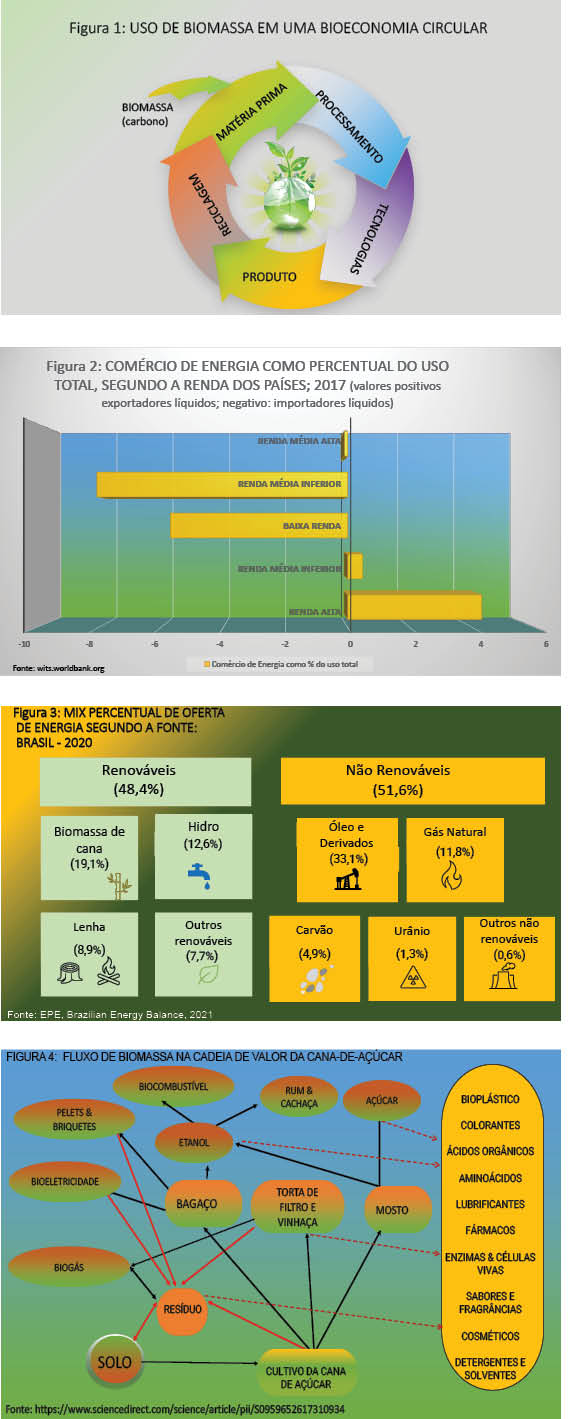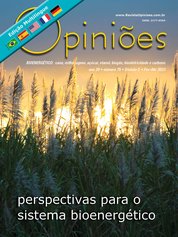Heloisa Lee Burnquist
Professora de Economia e Administração da Esalq-USP
OpAA75
Reafirmando o potencial da energia da biomassa da cana-de-açúcar
O sistema energético é a base da economia moderna que possibilita o avanço na produção de vários setores e na nossa qualidade de vida. À medida que a população mundial cresce, aumenta também a demanda por energia. O consumo anual global de energia vem sendo estimado em 580 milhões de terajoules, o equivalente a 13.865 milhões de toneladas de petróleo, e aumentará 30%, entre 2000 e 2040.
 Para atender a essa demanda, é essencial que o sistema energético seja gerido de forma responsável, aumentando a disponibilidade com segurança, equidade e, ao mesmo tempo, reduzindo as emissões de gases de efeito estufa. Esse tem sido um dos grandes desafios globais, designado trilema do sistema energético global:
Para atender a essa demanda, é essencial que o sistema energético seja gerido de forma responsável, aumentando a disponibilidade com segurança, equidade e, ao mesmo tempo, reduzindo as emissões de gases de efeito estufa. Esse tem sido um dos grandes desafios globais, designado trilema do sistema energético global: 1. Segurança: atender à demanda de energia atual e futura, de forma confiável, resistente e resiliente, recuperando-se rapidamente de interrupções e gerindo eficientemente fontes domésticas e importadas, com infraestrutura energética bem distribuída.
2. Equidade: fornecer acesso universal à energia confiável, abundante e barata para uso doméstico e comercial, inclusive acesso a combustíveis limpos para cozinhar e a um mínimo necessário de eletricidade.
3. Sustentabilidade: transição energética para fontes renováveis, com maior produtividade e eficiência da geração, transmissão e distribuição, promovendo a descarbonização e a melhora da qualidade do ar.
Uma estratégia de resposta ao trilema é a mudança do paradigma em direção à bioeconomia circular. A obtenção de energia adicional a partir de fontes renováveis e locais, a intensificação e o aumento do aproveitamento do recursos, até se chegar ao ideal: em que tudo que seja descartado em uma etapa da produção possa ser aproveitado por outra. Avanços tecnológicos, políticas e mudanças de atitudes são fundamentais para isso, como mostra a Figura 1.
A bioeconomia baseia-se na ideia de que fontes de energia renováveis podem ser usadas para criar um fluxo circular de energia, materiais e nutrientes, formando um sistema de circuito fechado, permitindo que sejam usados várias vezes. Essa abordagem de produção de energia é muito mais sustentável e eficiente que sistemas lineares (aquisição-produção-uso-descarte), com recursos finitos, como os combustíveis fósseis. Além disso, as fontes de energia renováveis emitem menos, ajudando a reduzir a poluição do ar e outros impactos ambientais. O emprego de energia renovável é economicamente mais eficiente, envolvendo menores custos na produção de energia.
Avanços tecnológicos têm viabilizado a incorporação de uma gama diversificada de fontes energéticas renováveis e com baixos impactos ambientais, tanto no âmbito local como global. A velocidade dessas transições, no entanto, tem sido aquém das metas estabelecidas para evitar mudanças climáticas irreversíveis para o planeta.
As dificuldades para efetivar as mudanças necessárias para corrigir o curso de nossa trajetória não se resume à matéria-prima empregada. Trata-se da alteração de um sistema dinâmico em funcionamento, onde mudanças se refletem com grande capilaridade pelas economias e com efeitos de difícil previsão. Foi considerando esses aspectos que pesquisadores, executivos e formuladores de política se debruçaram sobre novos conceitos para definir estratégias de maior alcance, tal como a bioeconomia circular.
Fatores conjunturais também têm sido críticos nessa transição, como a pandemia de Covid-19, que expôs a fragilidade do sistema energético atual, ainda bastante dependente de matéria-prima fóssil (cerca de 83%).
Quando as fronteiras se fecharam, a interrupção dos fluxos de produtos e insumos estratégicos em um sistema orientado pela dependência externa provocou forte impacto recessivo, frente à desorganização rápida e inesperada das cadeias produtivas e dos fluxos logísticos nas cadeias de suprimentos.
Bilhões de pessoas ao redor do planeta mudaram radicalmente os seus hábitos, e as taxas de crescimento dos países desabaram, retraindo a demanda e o preço de petróleo para patamares nunca vistos anteriormente.
Isso fragilizou o apoio às energias renováveis mais sustentáveis, em grande parte ainda sem um mercado consolidado. O risco associado a novos investimentos também aumentou.
Já a invasão da Ucrânia pela Rússia provocou mudanças em sentido contrário. Os preços aumentaram, resultando em grande volatilidade e riscos no suprimento adequado à demanda por energia, provocando instabilidade econômica, custo social, pois muitos países, particularmente os de menor nível de renda, ainda são importadores líquidos de energia (conforme demonstrado na Figura 2 da página anterior).
Os preços mais altos potencializaram o argumento da transição para as energias renováveis. No entanto, também resultaram em inflação, menor crescimento e rupturas nos mercados financeiros, fenômenos estes já iniciados em 2022 e que têm impactos negativos sobre investimentos volumosos requeridos para amadurecer as inovações, desestimulando a mobilidade de capital de investimento entre países.
O Brasil encontra-se em posição favorável devido à composição de seu sistema energético. Em 2020, a oferta total de energia atingiu 287,6 milhões de tep (tonelada equivalente de petróleo), 48% dos quais vieram de fontes renováveis (conforme demonstrado na Figura 3 da página anterior). Nenhum país no mundo guarda essa proporção por território, tamanho da população e tamanho econômico.
O que tem impedido o País de se apresentar ao mundo como um modelo de sistema energético responsável e sustentável? É urgente que medidas sejam implementadas para potencializar o que pode ser considerado um dos maiores trunfos do País. Desde o século passado, a biomassa é aproveitada, particularmente com o aumento das alternativas dentro do setor sucroenergético.
A cana-de-açúcar é uma cultura altamente valorizada pelo seu potencial de produção de biomassa para sistemas bioenergéticos, destacando-se como uma das fontes mais produtivas e eficientes de biomassa devido à sua rápida taxa de crescimento, alto rendimento e capacidade de produzir grandes quantidades de açúcar.
Esse açúcar pode, então, ser convertido em bioetanol, uma importante fonte de energia renovável. Além disso, o alto teor de açúcar da cana-de-açúcar a torna adequada para a produção de outros bioprodutos, como bioplásticos e biogás (conforme demonstrado na Figura 4 da página anterior).
Assim, na conjuntura atual, mais uma vez a intensificação do uso de derivados da cana no sistema bioenergético apresenta-se como uma das melhores alternativas para o Brasil. Isso em termos de desenvolvimento de processos de produção circular, bem como da proximidade dos consumidores, facilidade de transmissão, mercados secundários de carbono, dentre outros aspectos que a favorecem.
A importância da cana-de-açúcar precisa ser reforçada na conjuntura atual, sendo reconhecida como uma ferramenta poderosa no desenvolvimento de um sistema bioenergético sustentável para a economia nacional. Seu alto teor de açúcar e rápida taxa de crescimento a tornam uma fonte ideal de biomassa para a produção de energia renovável. Tem capacidade de converter grande porção da economia de base fóssil em uma bioeconomia circular em um horizonte mais próximo, com tecnologia nacional, e, portanto, precisa reassumir sua posição estratégica no desenvolvimento socioambiental brasileiro.




